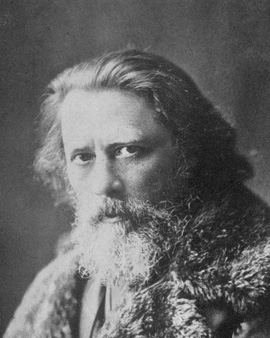Mihaly von Zichy was a Hungarian painter of the 19th century. He was born in 1827 in the Austrian Empire and studied law and painting in Pest, but his works of art were not very successful in the Empire. Because he had to live on the minimum subsistence level, he decided at the age of 20 to seek his fortune abroad and therefore moved to St. Petersburg. There von Zichy experienced a first appreciation of his work and a first financial upswing: he first became a private drawing teacher in the wake of Grand Duchess Helena Pavlovna and later even court draughtsman for Tsar Alexander II. These appointments also influenced his Russian creative phase, during which von Zichy mainly made portraits of various important Russian courtiers.
After almost 30 years in Russia, Zichy finally moved to Paris, where he met the painters Félicien Rops and Gustave Doré, who not only worked with him but also influenced his style. In the course of this, von Zichy also painted one of his better known pictures: the picture Kurtisane, inspired by the main character of Zola's novel "Nana". He finally spent the rest of his life at the court of the Russian Tsar, where he remained artistically active until his old age.
Stylistically, Zichy is assigned to Hungarian Romanticism and is considered one of the most important representatives of this epoch. The main focus of his work is above all the subject of physical love, which he treated and displayed without taboos and prejudices. Although he also worked as a graphic artist and illustrations to works of Hungarian poets and writers. His passion, however, was erotic depictions, which he put on paper or canvas in the form of drawings, oil paintings and watercolours. Zichy was not interested in anatomically correct or particularly realistic depictions of various love games and lustful motifs. He was always much more interested in the fantastic, the supernatural and the horrible. That is why his paintings often contain a transcendental and mystical component that is not reflected in the painterly representation. In this way, he leaves room for interpretation and speculation and underlines his eccentric inventions with daring colour games. Today, Zala has its own museum dedicated to the work of Zichy, reflecting the great importance of the artist for Hungarian Romanticism.
×





.jpg)
.jpg)
.jpg)
.jpg)
.jpg)
.jpg)
.jpg)
.jpg)
.jpg)
.jpg)
.jpg)
.jpg)
.jpg)
.jpg)
.jpg)
.jpg)
.jpg)
.jpg)
.jpg)
.jpg)
.jpg)
.jpg)
.jpg)
.jpg)
.jpg)
.jpg)
.jpg)
.jpg)
.jpg)
.jpg)
.jpg)
.jpg)
.jpg)
.jpg)
.jpg)
.jpg)
.jpg)
.jpg)
.jpg)
.jpg)
_(oil_on_canvas)_-_(MeisterDrucke-898680).jpg)
_(oil_on_canvas)_-_(MeisterDrucke-898680).jpg)
_-_(MeisterDrucke-935525).jpg)
_-_(MeisterDrucke-935525).jpg)
_in_a_sleigh_crosses_a_village_under_snow_Watercolo_-_(MeisterDrucke-950661).jpg)
_in_a_sleigh_crosses_a_village_under_snow_Watercolo_-_(MeisterDrucke-950661).jpg)
_Aquarelle_de_Mihaly_-_(MeisterDrucke-995277).jpg)
_Aquarelle_de_Mihaly_-_(MeisterDrucke-995277).jpg)
_pub_1901_in_Leipzig_(heliograv_-_(MeisterDrucke-1105359).jpg)
_pub_1901_in_Leipzig_(heliograv_-_(MeisterDrucke-1105359).jpg)
_pub_1901_in_Leipzig_(h_-_(MeisterDrucke-1105360).jpg)
_pub_1901_in_Leipzig_(h_-_(MeisterDrucke-1105360).jpg)
_pub_1901_in_Leipzig_(heliogravure)_-_(MeisterDrucke-1105361).jpg)
_pub_1901_in_Leipzig_(heliogravure)_-_(MeisterDrucke-1105361).jpg)
.jpg)
.jpg)
_Derriere_la_ligne_des_troupes_de_fr_-_(MeisterDrucke-1320268).jpg)
_Derriere_la_ligne_des_troupes_de_fr_-_(MeisterDrucke-1320268).jpg)
_-_Peinture_de_Mihaly_Zichy_(1827-1906)_huile_sur_toil_-_(MeisterDrucke-1323411).jpg)
_-_Peinture_de_Mihaly_Zichy_(1827-1906)_huile_sur_toil_-_(MeisterDrucke-1323411).jpg)
.jpg)
.jpg)
.jpg)
.jpg)
.jpg)
.jpg)
.jpg)
.jpg)
 - (MeisterDrucke-21376).jpg)
 - (MeisterDrucke-21376).jpg)
.jpg)
.jpg)
.jpg)
.jpg)
.jpg)
.jpg)
 pub - (MeisterDrucke-375176).jpg)
 pub - (MeisterDrucke-375176).jpg)
.jpg)
.jpg)
 - (MeisterDrucke-574214).jpg)
 - (MeisterDrucke-574214).jpg)
.jpg)
.jpg)
.jpg)
.jpg)
.jpg)
.jpg)
.jpg)
.jpg)
.jpg)
.jpg)
.jpg)
.jpg)
.jpg)
.jpg)
.jpg)
.jpg)
.jpg)
.jpg)
.jpg)
.jpg)
.jpg)
.jpg)
.jpg)
.jpg)
.jpg)
.jpg)
.jpg)
.jpg)
.jpg)
.jpg)
.jpg)
.jpg)
.jpg)
.jpg)
.jpg)
.jpg)
.jpg)
.jpg)
.jpg)
.jpg)
.jpg)
.jpg)






